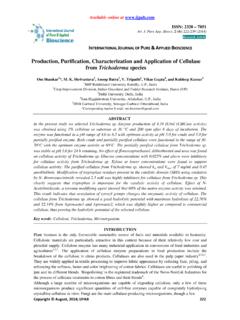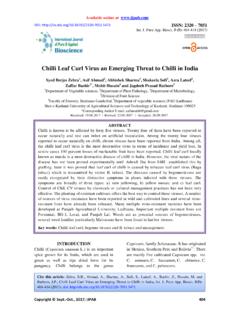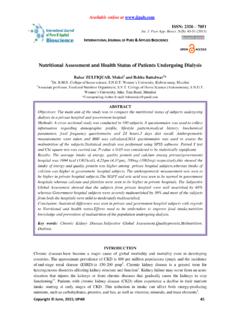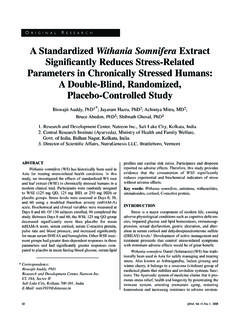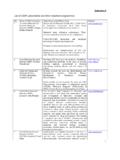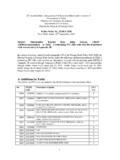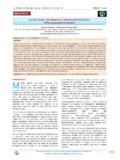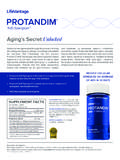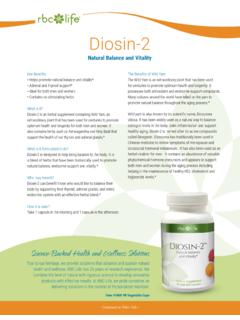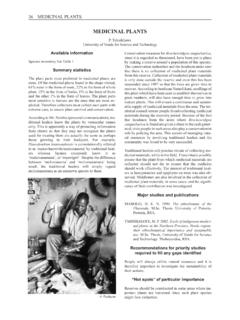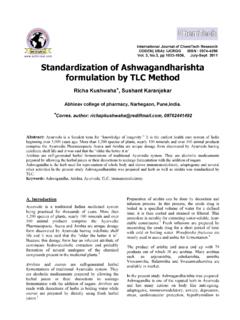Transcription of Effects of the Biophytum sensitivum (L.) DC leaf …
1 Available online at Mhaske and Gonjari Int. J. Pure App. Biosci. 3 (6): 183-191 (2015) ISSN: 2320 7051. DOI: ISSN: 2320 7051. Int. J. Pure App. Biosci. 3 (6): 183-191 (2015). Research Article Effects of the Biophytum sensitivum (L.) DC leaf extracts on anti-angiogenic properties by chorioallantoic membrane (CAM) assay Manisha Mhaske* and Ghanshyam Gonjari1. * zoology, Yashvantrao chavan institute of Science, Satara, 415001. India 1. Director, Rayat institute of Research and Development(RIRD)- Satara, 415001- India *Corresponding Author E-mail: ABSTRACT. Biophytum sensitivum (Linn) DC (Oxalidaceae) is a medicinal plant used as antitumor, radioprotective, antibacterial, antidiabetic and ayurvedic medicine. Antiangiogenic property of acetone extract of B. sensitivum (leaf) is evaluated by chick chorioallntoic membrane (CAM) assay in vivo. Treatment doses of leaf extracts were administered at 48, 72 and 96hrs of incubation by window method and observed for angiogenesis at 144hrs of development.
2 The results by comparing with DNS control and normal embryo showed prominent antiangiogenic effect with significant reduction in number and area of tertiary vitelline veins. The inhibition of angiogenesis was highly significant at 48hrs. The role of metabolites acting by obstructing signaling of angiogenic agents from epithelial cells or may be inducing apoptosis is discussed for it's anti-angiotherapantic use. Key words: anti-angiogenesis, Biophytum sensitivum , chick chorioallntoic membrane (CAM) assay. INTRODUCTION. Angiogenesis is a multi-stepped process of sprouting blood vasculature by endothelial cell migration, proliferation and tube formation. It plays an important role in pathological processes such as wound healing, placentation, embryogenesis, inflammatory disorders and metastasis of tumor growth13,22,48. The process of angiogenesis is an important strategy for tumor growth and metastasis9,14,35.
3 Several pro- angiogenic inducer factors such as fibroblast growth factor (FGF)34,50, Vascular permeability factor/Vascular endothelial growth factor (VPF/VEGF)10,44 and angiopoietins53 have played an important role in regulation of angiogenenesis process and generation of cancer cells. Whereas factors such as angiostatin, endostatin and thrombospondin inhibit the process of angiogenesis15. Any imbalance in the angiogenesis leading to numerous complex diseases such as chronic inflammatory disorders, cancer and some pregnancy related diseases such as intrauterine growth restriction and preclampsia4,7,28, antitumor5, cell mediated immune response19, anti-cancer effect16 and lowered blood sugar on nicotinamide induced rats and streptozotocin43. Traditionally many herbs and phytochemicals have been recognized as a rich source of angiogenesis both in vitro and in-vivo eg. Benincasa hispida33, Withania somnifera root36 and Gastrodia elata Blume1.
4 Biophytum sensitivum DC. (Oxalidaceae) is a small, sensitive, annual herbs growing throughout the tropical regions of South Asia, Africa and Madagascar54. Cite this article: Mhaske, M. and Gonjari, G., Effects of the Biophytum sensitivum (L.) DC leaf extracts on anti-angiogenic properties by chorioallantoic membrane (CAM) assay, Int. J. Pure App. Biosci. 3(6): 183-191. (2015). doi: Copyright December, 2015; IJPAB 183. Mhaske and Gonjari Int. J. Pure App. Biosci. 3 (6): 183-191 (2015) ISSN: 2320 7051. 39. Natarajan and Srinivasan have reported that acetone extract of dried B. sensitivum (leaf) showed anti- bacterial activity by chorioallantoic membrane (CAM) assay. According to Vijayan et B. sensitivum (leaf) in acetone extract inhibited the growth of fungal pathogens and having excellent larvicidal and pupicidal potential activity against Aedes aegypti strain51. While the ethanolic extract of B.
5 sensitivum exhibited maximum antifertility activity26. The ethanolic extract of B. sensitivum DC. significantly showed the peptic anti-ulcer activity induced by aspirin in wistar albino rats3 and anti-bacterial activity39. The chick embryo CAM developed as a successful, feasible and sensitive model to investigate physiological and pathological circumstances and in vivo research on angiogenesis and anti- angiogenesis41,47. As no any report available on anti-angiogenic activity, the present study was carried out to evaluate the anti-angiogenic activity of B. sensitivum (leaf) in acetone extract by chicken chorioallantoic membrane (CAM) assay. Objective of study The objective of this study is to assess the effect of acetone extract of B. sensitvum (leaf) on the tertiary vitelline veins (TVV) of chick chorioallantoic membrane (CAM) assay. Statistical analysis The data was expressed as Mean SEM and the statistical significance between groups was analyzed11.
6 Using student t' test. The values of p > , p > , p > were considered as significant. MATERIAL AND METHODS. Plant material and preparation of extracts: The properly identified fresh leaves of B. sensitivum were collected from the local area of Satara district, Maharashtra, India. The fresh leaves were chopped into smaller pieces and air dried for week in shady places. The dried pieces were grinded into fine powder. The leaves of experimental material were soaked in acetone extract and filtered through Whatman filter paper The material was evaporated using speed vacuum evaporator (Buchi type). The yield extract was stored at 40C under refrigerated condition till needed for. The 1mg of acetone extract was dissolved in 1ml dextrose with normal saline (DNS) was purchased from Mark-Bioscience Ltd, Goa (G21730031, Exp. Dec. 2015). DNS is a medicated saline used to make proper concentration of extract for treatment on CAM assay.
7 Chorioallantoic membrane assay: The fertilized eggs of Gallus gallus (murghi) were obtained from animal hatchery, Satara. The eggs were swabbed with 70% alcohol and kept in incubator at 37-380C with relative humidity of 70-75%. The treatment doses were initiated at hrs stated as 48, 72 and 96hrs and development were till continued upto 144hrs on completion of CAM ventilation and capillary networking. Dose selection and administration by window method : The dose of B. sensitivum (leaf) extract were selected on the basis of dose that showed 100% survival without any mortality on hatching. The selected doses of B. sensitivum (leaf) mixed with 1ml volume of DNS and were administered on different developed 48, 72 and 96hrs incubated embryos. The extract were prepared in three groups as Sham, DNS control and treated. The normal group of embryo was maintained as normal group. The embryo CAM of 48, 72 and 96hrs development were exposed to 1mg/ml leaf acetone extract as described in Table-1 by window method30.
8 The windows were resealed using sterilized adhesive tapes and CAM were studied after 144hrs. After 144hrs, the eggs shell were removed and embryos along with yolk were placed gently in PBS. containing saline water. The embryo CAM were imaged with digital camera and kept further for imaged analysis on computer. Quantification of angiogenesis: Angiogenesis was quantified by tertiary vitelline capillaries for antiangiogenic response. The bifurcation points were used as initiation and termination markers. Area was measured on stereoscopic microscope and was confirmed by using graph transparencies. The observed alterations are presented in Table 2 and Fig 1 and 2. Copyright December, 2015; IJPAB 184. Mhaske and Gonjari Int. J. Pure App. Biosci. 3 (6): 183-191 (2015) ISSN: 2320 7051. Evaluation of CAM angiogenesis: The morphometrical evaluation made by Melkomian et The total CAM area was calculated as Area =(1/2A)X(1/2B)X.
9 Where A is the longest length, B is longest width and = The number of secondary and tertiary blood vessels branching points and it's morphometric evaluation were counted manually on computer image49. For histological evaluation paraffin block of CAM was sectioned at 5 m thickness by rotary microtome. RESULTS AND DISCUSSION. The anti-angiogenic activity of B. sensitivum (leaf) in acetone extract have been determined by using chicken chorioallantoic membrane(CAM) assay (in vivo). The CAM assay is widely used for study of histological procedures45, proliferation of new vessel and tumor neo-vascularization46. For histological evaluation all different developmental staged embryos were observed at 144hrs Morphometric evaluation: For anti-angiogenic evaluation branching number of primary, secondary and tertiary blood vessels were counted at 144hrs. The number of primary, secondary and tertiary blood vessels showed constant at 48, 72 and 96hrs but slightly increase in number of blood vessels were noted in sham control embryo.
10 While significantly increase in number of primary, secondary and tertiary blood vessels were noted in DNS control embryo. Treatment of acetone extract of (leaf) showed marginal reduction in the number of blood vessels at all hrs of treatment but significantly reduction in the number and proliferation of blood vessels were ( ) observed at 48hrs treatment. While at 72 and 96hrs decrease in number of blood vessels were ( and respectively). Total area of CAM was significantly inhibited at 48 and 72hrs treatment of CAM embryo by ( and respectively). While at 96hrs total area of CAM. embryo showed normalized as that of normal embryo Plate 1, Table 2 and and 2). Table 1: Groups as per treatment of B. sensitivum (leaf) extracts at different developmental stages of chick embryo in hrs Groups as per Groups as per time of exposure Final development and hrs of developmental stages in initiations sacrifice hrs 48 72 96.
